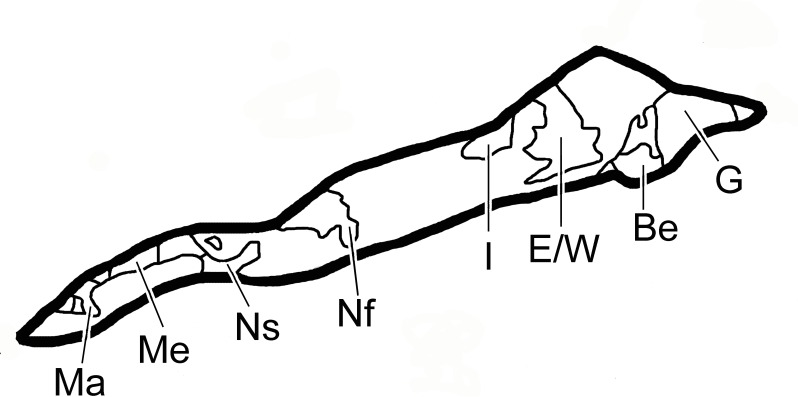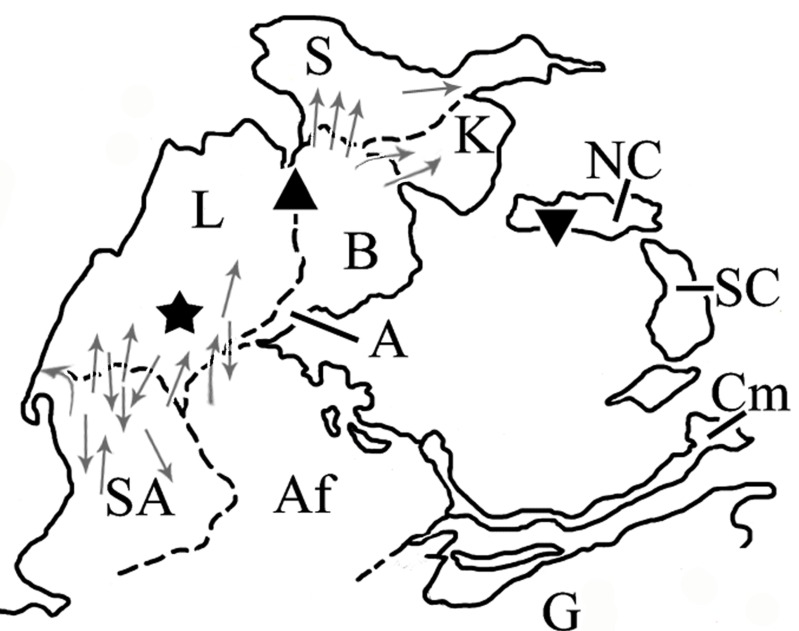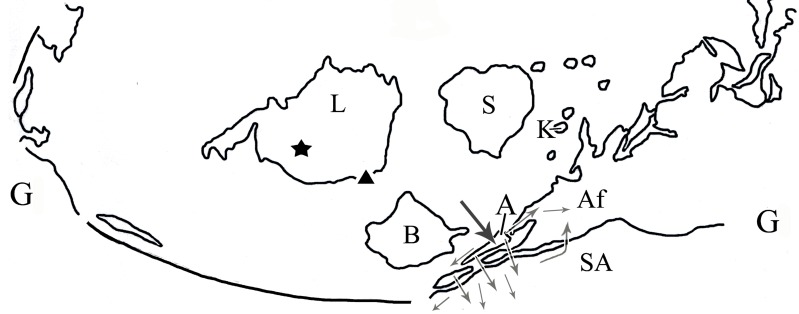
O. The Avalonia terrane, and some lands representing it today, of the Gondwana
continent deriving from breakup of the supercontinent Pannotia in the Early
Cambrian Period, Paleozoic Era, 540 million years ago and well prior to
formation of the supercontinent Pangaea. B, Belgium; E/W, England/Wales; G,
Germany; I, Ireland; Ma, Massachusets; Me, Maine; NS, Nova Scotia; Nf,
Nefoundland (from Shelley & Golovatch, 2011, Insecta Mundi 0158)

2. Land areas in Early Ordovician Period,
Paleozoic Era, 480 mya, when the Avalonia terrane (A), harboring
ancestral millipeds, rifted from Gondwana (G) and began drifting
toward Baltica (B), shown by bold arrow. Ancestral
populations were thereby partitioned between Avalonia and Gondwana.
Dispersions and evolution continued in Gondwana (light arrows), but other land
masses were devoid of millipeds.
EVENTS AND APPROXIMATE DATES IN EARLY DIPLOPOD EVOLUTION (adapted
from Shelley & Golovatch, 2011, Insecta Mundi 0158, Table 6, pp.
116-120).
1. (Diagram 1). 524 ma (million years ago). Paleozoic Era, Mid-Cambrian
Period. Evolution begins as ancestral form(s) crawl onto still
attached Avalonia Terrain, disperse onto Gondwana proper, and
radiate explosively into empty terrestrial environments in absence
of predators and with all niches vacant and unoccupied.
2.
524-480 ma. Paleozoic, Mid-Cambrian-Early Ordovician. Penicillata/Chilognatha,
Pentazonia/Helminthomorpha, Colobognatha/Eugnatha, Julida/
Nematophora/Merocheta diverge. Polyxenida, Polyzoniida,
Siphonocryptida, Spirostreptida s. l./Cambalidea,
Chordeumatida, Siphoniulida, and Polydesmida arise and spread
between Avalonia and Gondwana proper. 3. (Diagram 2). 480 ma. Paleozoic,
Early Ordovician. Ancestral populations of Pentazonia, Colobognatha,
Eugnatha, Nematophora, and the existing orders Polyxenida,
Polyzoniida, Siphonocryptida, Spirostreptida s. l./
Cambalidea, Chordeumatida, Siphoniulida, and Polydesmida are
partitioned between Avalonia & Gondwana as Avalonia rifts from
latter and begins drifting towards Baltica. 4. 480-450 ma.
Paleozoic, Ordovician. Glomeridesmida, Sphaerotheriida,
Siphonophorida, Spirobolida, Epinannolenidea, Spirostreptidea,
Stemmiulida arise and disperse on Gondwana; partitioned Gondwanan
populations of Polyxenida, Polyzoniida, Siphonocryptida, Cambalidea,
Chordeumatida, Siphoniulida, Polydesmida evolve and disperse farther
as Avalonia drifts northward towards Baltica; probably little to no
divergence, dispersal, or advancement among partitioned populations
confined to Avalonia due to its relatively small size and limited
number of
niches. 5. (Diagram 3). 450 ma. Paleozoic, Late Ordovician. As land masses
collide, forms confined to Avalonia for 30 my disperse onto Baltica
and radiate explosively into its empty terrestrial environments with
all niches vacant; probable burst of evolution and origins of orders
Glomerida, Platydesmida, Julida, Callipodida; divergences and
dispersals continue among forms remaining on Gondwana. 6.
(Diagram 4). 440
ma. Paleozoic, Early Silurian. As land masses collide to form
Euramerica, forms on Baltica + Avalonia disperse onto Laurentia,
again radiating explosively into its empty terrestrial environments
with all niches vacant; probable second burst of evolution further
differentiating Glomerida, Platydesmida, Julida, Callipodida, and
possibly Cambalidea and Polydesmida; divergences and dispersals
continue among forms remaining on Gondwana. 7. 415 ma.
Paleozoic, Late Silurian. Spirobolidan population on Gondwana
partitioned as North China terrane rifts from proto-Australia region
and begins northward transit to Siberia (+ Kazakhstania); forms on
Euramerica differentiate and disperse farther into it,
Archidesmus macnioli fossilized in Proto-Scotland;
divergences and dispersals continue among forms remaining on
Gondwana.
8. 400 ma. Paleozoic Era, Early Devonian Period. Forms on Gondwana further
partitioned as South China and Southeast Asia terranes rift from proto-Australia
region and begin northward transits to Siberia (+ Kazakhstania); spirobolidans
on drifting North China terrane continue passive transit northward; divergences
and dispersals continue among forms on Euramerica and those remaining on
Gondwana.
9. 356 ma. Paleozoic, Early Carboniferous. After
collision, forms on Euramerica spread into Siberia + Kazakhstania,
which merged Late Devonian (370 ma). Spirobolidans on North
China terrane and forms on South China and Southeast Asia terranes
continue passive transits northward. Dispersals continue among forms
remaining on Euramerica and Gondwana.
10.(Diagram 5). 306 ma. Paleozoic, Late Carboniferous.
Collision of Euramerica + Siberia + Kazakhstania with proto-South
America/Africa part of Gondwana, forming West Pangaea, allows
separately evolving northern and southern diplopod faunas to mix for
first time. Proto-South American forms of Glomeridesmida,
Siphonophorida, Spirobolida, Spirostreptidea, Stemmiulida spread
directly into proto-Mexico and then into proto-southwestern US.
US/Illinois oniscomorph pentazonian fossilizes. Spirobolidans on
North China terrane and forms on South China and Southeast Asia
terranes continue passive transits northward. Dispersals continue
among forms remaining on Euramerica and Gondwana.
|
|

OO. The micro-continents Baltica (B) and Laurentia (L) that lay in the Iapetus
Ocean north of Gondwana in the Cambro-Ordovician Periods, with positions of
present-day
European countries and US & Canadian states/provinces. Solid interior lines
represent coast lines at this time with the areas inside being above sea level;
lighter outside lines represent margins of continental shelves. Triangle, future
location of the Scottish Helminthomorph Silurian fossil (uncertain order),
Archidesmus macnioli; Star, future location of the non-spinose oniscomorph
pentazonian Carboniferous fossil in Illinois, USA.

3.
Land areas in Late Ordovician Period, Paleozoic Era, 450 mya, when Avalonia (A)
merged with Baltica (B), thereby allowing the ferried populations to disperse
into Baltica, which did not then harbor millipeds. Dispersions and evolution
continued on Gondwana (G), while other land masses were devoid of millipeds.
Separate "northern" and "southern" diplopod faunas thus originated that were
effectively evolving in "parallel."

5. Land Masses in Late Carboniferous Period, Paleozoic Era, 306 mya, after
Siberia (S) + Kazakhstania (K) had merged with each other and the Baltica (B)
part of Euramerica, which had also merged with the proto-South America/Africa
part of Gondwana. The arrows denote dispersals from Baltica into Siberia +
Kazakhstania and mutual dispersals and faunal exchanges between Euramerica and
the SA/Af part of Gondwana (G); for the first time, the separately evolving
northern and southern diplopod faunas were able to mix. By this time, dispersals
had extended throughout Gondwana, and all land masses contained millipeds. The
North China (NC) and South China (SC) terranes had rifted from the
proto-Australia part of Gondwana and were ferrying gondwanan millipeds to what
is now eastern and southeastern Asia. Inverted Triangle, approximate location of
Gobiulus sabulosus, the Mongolian Cretaceous spirobolidan fossil.
11. 270 ma. Paleozoic, Early Permian. Continued northward
dispersals by Glomeridesmida, Siphonophorida, Spirobolida, Spirostreptidea,
Stemmiulida in proto-Mexico/proto-southwest US part of West Pangaea.
Spirobolidans on North China terrane and forms on South China and Southeast Asia
terranes continue passive transits northward. Dispersals continue among forms
remaining on West Pangaea and Gondwana.
12. 255 ma. Paleozoic, Late Permian. After collision,
Spirobolidans on North China terrane spread into Siberia + Kazakhstania part of
West Pangaea. Forms on South China and Southeast Asia terranes continue passive
transits northward. Continued north/south dispersals in Mexican part of West
Pangaea; continued dispersals in rest of West Pangaea and Gondwana.
13. 250 ma. Mesozoic Era, Early Triassic Period. Glomerida,
Platydesmida, Julida, Callipodida begin dispersing east-southeastward along
southern margin of East Pangaea. Forms on South China and Southeast Asia
terranes continue passive transits northward. Continued north/south dispersals
in Mexican part of West Pangaea and continued dispersals in rest of West Pangaea
and Gondwana.
14. 220 ma. Mesozoic, Late Triassic. After collision, Gondwanan
forms on South China terrane spread into East Pangaea and mix with Euramerican
forms on latter, which spread into merged terrane. Continued dispersals in all
directions in West Pangaea.
15. 195 ma. Mesozoic, Early Jurassic. Pangaea now fully
assembled. After collisions, Gondwanan forms on Southeast Asia terranes spread
into East Pangaea and mix with Euramerican forms on latter that spread onto
merged terranes. Continued dispersals in all directions in West Pangaea.
16. 152 ma. Mesozoic, Late Jurassic. Pangaea rifts into Laurasia
+ a new and somewhat differently constituted Gondwana. Proto-Mexican forms of
Glomeridesmida, Siphonophorida, Spirobolida, Spirostreptidea, Stemmiulida
disperse southward into proto-Central America that begins forming on southern
border of proto-Mexico.
|

1.
Land areas in the Mid-Cambrian Period, Paleozoic Era. Bold arrow
represents emergence, around 524 mya, of the ancestor of Diplopoda
onto the Avalonia terrane that was still attached to Gondwana;
lighter arrows represent initial dispersals throughout Avalonia and
onto Gondwana proper. At this time, no other land masses harbored
millipeds. A, Avalonia; Af, proto-Africa region of Gondwana; B,
Baltica; G, Gondwana; K, Kazakhstania; L, Laurentia; S, Siberia; SA,
proto-South America region of Gondwana.

4. Land masses in Early Silurian Period, Paleozoic Era, 440 mya,
after Baltica (B) + Avalonia (A) merged with Laurentia (L) to form
Euramerica, thereby allowing ancestral stock on A + B to disperse
into L. Dispersions and evolution continued on Gondwana (G), while
other land masses were devoid of millipeds. Triangle, future site of
Scottish Archidesmus macnioli fossil; Star,
future site of US/Illinois oniscomorph pentazonian fossil.
17. 94 ma. Mesozoic, Late Cretaceous. Proto-North
American part of western Laurasia completely divided by marine
embayment; Glomerida, Platydesmida, Julida, Callipodida partitioned
into separate eastern & western populations. Formerly continuous
European/ North African populations of Glomerida, Platydesmida,
Julida, Chordeumatida partitioned as is continuous stemmiulid fauna
through west Africa and eastern Brazil as Africa rifts from South
America. Continuous Indian and Madagascan faunas partitioned as land
masses split. Continued southeast- and northwestward dispersals on
proto-SE Asia part of eastern Laurasia; continued dispersals onto
Gondwanan fragments. Spirobolidan, Gobiulus sabulosus
fossilizes in proto-Mongolia part of eastern Laurasia.
18. 66 ma. Mesozoic/Late Cretaecous-Cenozoic/Paleocene.
Formerly continuous (eastern) North American/European populations of
Glomerida, Platydesmida, Julida, Cambalidea, Chordeumatida,
Polydesmida partitioned (European Cambalidea becoming extinct in
Oligocene). South American populations of Glomeridesmida,
Siphonophorida, Spirobolida, Epinannolenidea, Spirostreptidea,
Stemmiulida, Polydesmida partitioned between South America and
proto-Antilles. 19. 50 ma. Cenozoic, Eocene. After
collision generates Himalayan orogeny, faunas of Asia and Indian
subcontinent mix; populations of Siphonophorida, Siphonocryptida,
etc., become isolated by rise of Himalayas. As embayment fully
closes, populations of Julida and Callipodida begin dispersing into
and filling void in central North America generating continuous
faunas of today and spreading southward into Mexico/ northern
Central America. Glomerida, Platydesmida, Polyzoniida, Cambalidea,
Chordeumatida, Polydesmida spread southward into Mexico/Central
America. Australia + New Guinea split from Antarctica + South
America, partitioning formerly continuous fauna. 20. 14 ma.
Cenozoic, Late Miocene. Continued dispersals north- and
southward of Glomeridesmida, Siphonophorida, Spirobolida, Cambalidea,
Chordeumatida, Stemmiulida, Polydesmida in Central America.
Antillean Arc fragments, trapping some forms on different individual
islands. Antarctica becomes an island after rifting from South
America then freezes and glaciates, eradicating all diplopods
thereon. Arabian peninsula begins rifting from Africa, thus
partitioning continuous spirostreptidean fauna. Formerly continuous
East Indian/ Southeast Asian faunas partitioned as Indonesian
islands now isolated by water.
20. 14 ma. Cenozoic, Late Miocene.
|